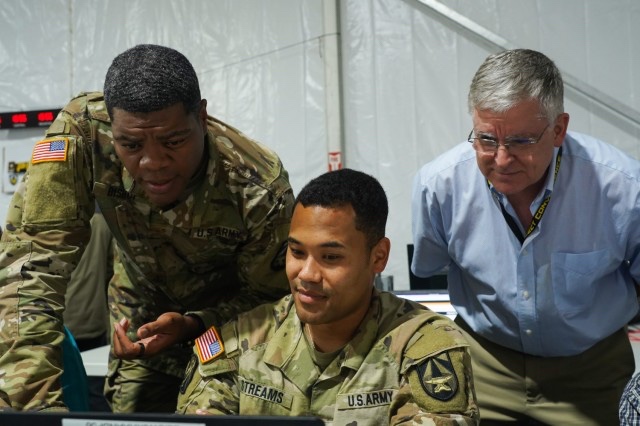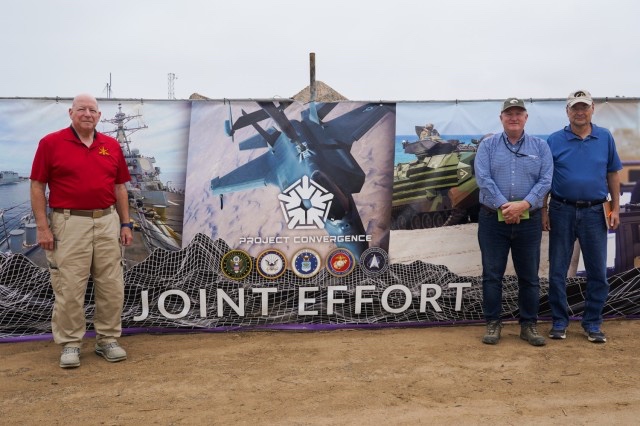
CAMP PENDLETON, Calif. — Bill Veitch, Jim Bailey and Russell Lange are expert military analysts who intimately understand the challenges the Army and its sister services are likely to face in the next 10-20 years. As Cold War Veterans and former air defense artillery Soldiers, the trio have firsthand experience preparing for the potential of major operations against formidable adversaries.
“We can drill down on the growing pains that the Army is having as it modernizes, coming out of counter-insurgency and going into large-scale combat operations,” said Veitch, an operations research/systems analyst with 49 years of experience working for the Army, including 28 years of experience serving as a Soldier.
Given their enduring commitment to the Army, the careers of Veitch, Bailey and Lange collectively represent roughly 130 years’ worth of military insights — insights they are now leveraging, along with a keen awareness of the changing nature of warfare, to help prepare future generations of warfighters.
“Most of the Soldiers today, their basis of experience is brigade-centric, because the brigade was the unit of action throughout the wars in the Middle East. But in the Cold War, the division and the corps were the central building blocks of combat power,” Lange explained.
Veitch, Bailey and Lange, who work for the U.S. Army Joint Modernization Command, have played an integral role in ensuring that Project Convergence 22, an all-service and multinational innovation experiment currently taking place at U.S. military installations across the Western United States, is actively utilizing, disseminating and preserving valuable warfighting knowledge.

New to the experiment’s data collection and analysis efforts this year is the Table of Knowledge, or ToK, an on-site group of military professionals with specialized technical skills who can directly inform and troubleshoot experimentation.
“During PC21, we identified a big gap within the way that we collected data and the way that we conveyed the message back to the leadership,” said Bailey, lead analyst for Scenario Alpha of PC22. “We weren’t really presenting the facts in the correct languages.”
To remedy the issue ahead of PC22, Bailey brainstormed solutions with Lange and Veitch, eventually coming up with the Table of Knowledge concept, which promotes sharing and integration of field experience and technological expertise. Representatives from Army Futures Command’s Capabilities Development Integration Directorates, or CDIDs, populate the table, providing a centralized and easily accessible resource for robust information on capabilities ranging from fires, air defense artillery, cyber and intelligence to maneuver and sustainment.
“They serve as subject matter experts, so that when an issue or problem occurs in the [exercise control center], we have the right people in this ToK to start troubleshooting and pursuing a response or an answer to the issue,” Lange said, referring to the many activities being monitored simultaneously by the experiment’s exercise control center.
“It’s like a think tank,” Bailey said of the effort. “We do a lot of cross-domain talk.”
Whether addressing an issue through the perspective of multiple areas of expertise or via one specific lens, the ToK was built to offer highly customizable information.
“It’s a Swiss Army knife,” Veitch said.
The presence of CDID points of contact at PC22 also means CDID commanders located around the country can quickly obtain information on how experimentation is progressing. At the same time, experiment participants can draw on CDID expertise to resolve any gaps in understanding.
Individuals occupying seats at the ToK are not only well-versed in their subject matter, but also eager to ensure others comprehend and are able to apply useful information.
“These are the up-and-coming captains and majors who are going to lead the Army of 2030,” Veitch said. “They’re seeing firsthand where modernization is going, how it is going to impact them and what they can do to influence it.”
Capt. Jessica Burris of the Intelligence CDID is one of the ToK experts assisting PC22 participants with inquiries related to new technologies undergoing assessment. Since the start of the experiment, she has been busy providing guidance on aspects of sophisticated sensor-to-shooter systems and other prototypes that rely on intelligence collection, processing, exploitation, and dissemination to operate.
“It’s incredibly beneficial,” Burris said of the ToK, adding that the availability of subject matter experts “provides a lot more context to issues or situations with pre-prototypes.”
Burris added that CDIDs are especially well-suited to offer guidance because they are the organizations within the Army tasked with developing new capability requirements, and have a thorough understanding of how in-development technologies and solutions should be operating.
Omar Gutierrez, an operations research/systems analyst with The Research and Analysis Center, has been working alongside the ToK and has observed just how influential the new resource can be.
“Every conversation I listen in on is rich,” he said of the interactions observed, noting that experts are consistently purposeful about “talking through an integration lens.”
Gutierrez has also seen how conversations that take place at the table encourage a more holistic appreciation of what the event’s various experiments collectively aim to accomplish.
“The operational ‘so what’ — that matters a lot,” Gutierrez said.
By Maureena Thompson, Army Futures Command

